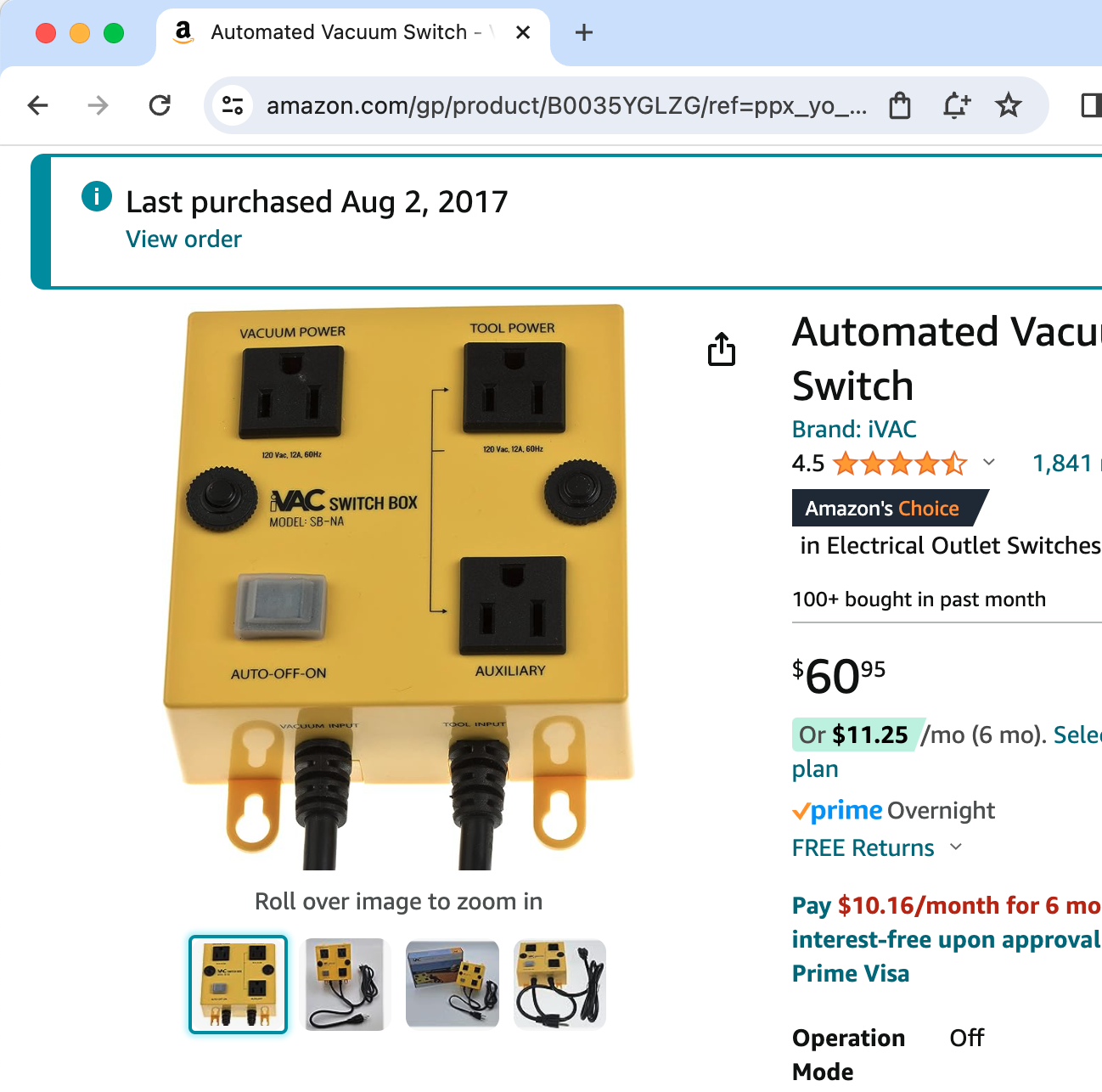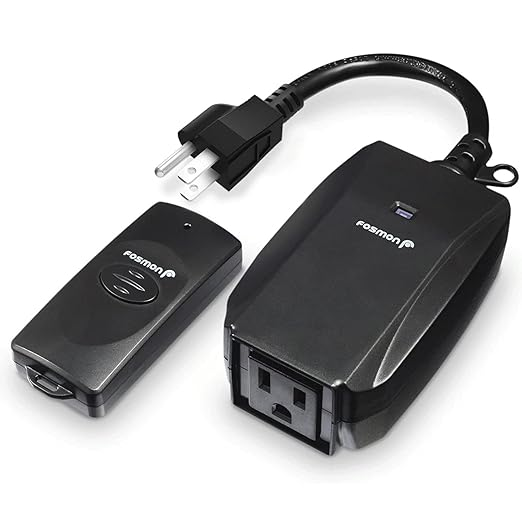❇️ Ortis Automatic Vacuum Switch → https://amzn.to/3HIzEhs
❇️ iVAC Automatic Switch Box → https://amzn.to/3w08xMb
❇️ Outdoor Wireless Remote → https://amzn.to/3UmHC7a
❇️ PSI Woodworking Long Ranger → https://amzn.to/42iUHk5
My friend Scott Markwood of https://www.mygrowthrings.com/ released a great tool video covering several useful additions to his woodworking shop. Among his list of new toys was an Ortis Automatic Vacuum Switch. Automatic switches add a tremendous degree of convenience to the workshop. By sensing the flow of electrical current in the main outlet circuit they can activate the auxiliary outlet automatically, thereby turning on a dust collector or vacuum.
This post covers four options for remotely powering on dust collection, some pros and cons, and the hardware I finally settled on after a few years of searching.
Ortis Automatic Vacuum Switch
The Ortis switch is a great option for remotely and automatically powering on dust collection. I've never used the Ortis, however, I have used a similar unit from iVAC, which I discuss a bit further down. Below are some of the advantages of this type of switch.
Pros
Automatically turn on dust collection. I sometimes forget to turn the darn thing on!
Remotely turns on dust collection. What a pain to be already for an operation, only to have to pause, walk over to the dust collector, and power it on.
Automatically turns off dust collection between 3 and 10 seconds after the main tool is powered down. This is convenient but also shows up on my disadvantages list. I'll explain a little further down.
Cons
Requires the main tool and the dust collection system to be plugged into the same electrical circuit. With two devices in operation, it's possible to overspend that 15 amp power budget and trip the unit's protection circuitry.
A 3 to 10-second delay may not be long enough. An advantage of using a high airflow dust collector is that it can process a volume of air equally to the volume of the shop in about 10 to 15 minutes depending on the shop size and the collector's ratings. I like to leave my collector on for several minutes after an operation so that it continues to scrub the air. Remember, air-born dust doesn't magically disappear when you shut off the tool.

The get a detailed description of the Ortis's specifications above, please check out the Amazon product page linked below.
❇️ Ortis Automatic Vacuum Switch → https://amzn.to/3HIzEhs
iVAC Switch Box
I used the iVAC system for several years and it worked great until I upgraded my shop vacuum system to a dust collector. Even though the dust collector is only 1 hp, having both devices running through the iVAC caused constant breaker trips. Can you see those round black buttons in the middle of the unit? I was pressing those A LOT! Eventually I gave my iVAC to a fellow woodworker whose system was more suited for it.
This unit has the same pro/con list as the Ortis from my perspective, so I won't repeat it hear. But I will say that the iVAC was a durable and reliable unit apart from the breaker trips.

The get a detailed description of the iVAC's specifications above, please check out the Amazon product page linked below.
❇️ iVAC Automate Switch Box → https://amzn.to/3w08xMb
Generic Outdoor Wireless Remote
I learned from the iVAC experience, that I would obtain more reliable and less frustrating performance by operating my power tools and dust collection system on separate electrical circuits. Separate circuits would result in fewer tripped breakers, but would also eliminate the possibility of automated control. But if I used a wireless system, I could power on the unit from across the garage, so that's something.
So I purchased a generic wireless control, similar to the FOSMON pictured below. We use this type of remote to reliably control our outdoor Christmas lighting. And it worked great for my dust collector, for a while. After a few months, the unit would no longer reliably shut off. Thinking it might be a fluke, and since these are relatively inexpensive, I bought a replacement. The replacement worked fine for a while, but then would not reliably turn on. I assumed that I had treated these units too roughly and that they just weren't built for my kind of abuse.
Pros
Remotely turn on/off dust collection.
Inexpensive.
Dust collector continues to clean the air until I power it down.
Cons
Does not start automatically.
Did not hold up to shop conditions.

The get a detailed description of the FOSMON's specifications above, please check out the Amazon product page linked below.
❇️ Outdoor Wireless Remote → https://amzn.to/3UmHC7a
PSI Woodworking Long Ranger
My latest attempt at solving this issue is the Long Ranger III from PSI Woodworking. I think we found a winner, folks. It has worked every time without fail so far. So, let's jump right into the pro/con lists.
Pros
Remotely turn on/off dust collection.
Durable and reliable.
Dust collector continues to clean the air until I power it down.
Right-sized remote, fits in the pocket but large enough not to get lost.
The red color on the remote makes it easier to spot in a garage filled with the detritus of an active project.
Remote takes a standard 9-volt battery as opposed to an obscure button battery.
Cons
Does not start automatically.
More expensive than other options.

The get a detailed description of the PSI Long Ranger's specifications above, please check out the Amazon product page linked below.
❇️ PSI Woodworking Long Ranger → https://amzn.to/42iUHk5
This post contains links connected to my Amazon Associates account. I may receive a small commission at no additional cost to the consumer.
